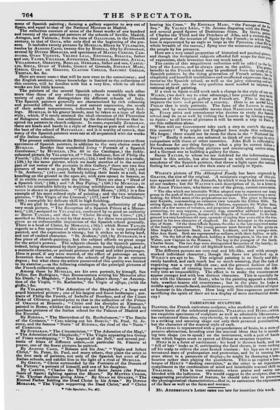WILKIE's picture of The Abbot.Turd Family has been engraved by
GRAVES, the size of the original. A miniature engraving of this pic- ture appeared in one of the Annuals, by which it may be known to many of our readers ; but Sir WALTER'S own description of it, in a letter o Sir ADAM FERGUSON, who forms one of the group, cannot come amiss. " The idea which our inimitable Wilkie adopted was to represent our family group in the garb of South country peasants, supposed to be concerting a merry. making, for which some of the preparations are seen. The place is the terrace near Kayside, commanding an extensive view towards the Eildon Hills. The sitting figure, in the dress of the miller, I believe, represents Sir Walter Scott, author of a few scores of volumes, and proprietor of Abbotsford. In front, aid
presenting, we nosy suppose, a country wag, somewhat addicted to poaching, stands Sir Adam Ferguson, Keeper of the Regalia of Scotland. In the back.
ground is every handsome old man, upwards ot eighty-four years old at the time, painted in his own character of shepherd. Ile also belonged to the numerous clan of Scott. 01 the three fe/bale figures, the elder is the late regretted mother of the family represented. The young persons most forward in the group are Miss Sophia Charlotte Scott, now Mrs. Lockhart, and her younger sister, Aliso Ann Scott. Both are represented as milkers, with their /eglias, or milk. pails. On the left of the shepherd, holding a fowling-piece, is the son of Sir \Vatter, now Captain in the Hussars. The boy is the youngest of the family, Charles Scott. The two dogs were distinguished favottrites of the family; the large one, a stag-hound of the old Highland breed, called Maida."
The different persons are very real and life-like, and with strongly marked individual character ; though the faces are pinched up, as Wit.KIE's are apt to be. The original painting is so freely and dd. cately handled, and each touch has so much meanirg, that the task of engraving was a very difficult one; and the present fashion of line. engraving—that of running lines across the face—converts the diffi- culty into an impossibility. The effect is to make the countenances appear younger and with less distinct character. This is epecially the case with the likeness of Scott; who in the painting appears a shrewd, hale, weather.beaten old countryman ; but in the plate he looks middle-aged, smooth-faced, meditative person, with little either of vigour or humour in his character. How long will line.engravers persist is sacrificing the spirit of their art to a display of mere mechanical dexte- rity ?


























 Previous page
Previous page